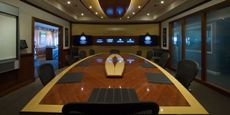
Technology has been changing the way we work for quite some time now, and shows no signs of stopping. Most innovations have hitherto been confined to the functional aspects of office furniture, like increasing physical well-being using ergonomic office chairs and adjustable height workstations. But more recently, many new advances have started to allow the integration of cutting edge tech in the workplace. Whether it’s virtual reality meetings or software that promotes team efficiency, it’s worth exploring how integrated technology might change the reality of the twenty-first century workplace.
Making the Usual Easier and the Unusual Usual
To date, much technological integration has focused on improving efficiency and streamlining current methods of working. Desks are routinely designed to hold computer workstations, with appropriate access for cabling and wiring solutions, hidden keyboard and mouse drawers, and so on. Conference rooms are now almost always equipped with projector systems that can be accessed remotely or that can have presentations loaded onto them via USB drives. All of this has resulted in improvements in productivity, but it isn’t exactly revolutionary in terms of changing workplace practice.
What’s more interesting is the growth of newer tech that has the potential to do just that. Take virtual reality: the obvious way to use it is to allow for virtual meetings and conference calls. But the wider possibilities are much more exciting – creating a virtual workspace that allows products to be built and tested without having to go to the huge expense of acquiring raw materials, for example. Employee training could also take place in a virtual world, and all the while the employee wouldn’t need to leave the comfort of their desk. Fully integrated VR units in all office workstations have the potential to become standard practice.
The Internet of Things
The connectivity of all the objects in the physical world is also moving closer to reality. There are an unprecedented number of devices that are able to connect with one another, and that are useful at home as well as in the workplace. At the moment it’s pretty straightforward to connect to the office printer, but how about connecting to the office coffee machine to have your latte ready whenever you saunter down the corridor to pick it up? Other possibilities include lighting, the shade and intensity of which can be computer-controlled, door locks, and window shades. Climate control is a big issue and integrated circuits in the appropriate office fittings that can be programmed at will are becoming more and more common.
Of course, the days of sitting at a terminal and centrally controlling everything are numbered. These days, smartphone access is the be-all and end-all of connectivity. Ambient proximity technology that can determine who and where you are based on pinging your smartphone are starting to take off. Smart conference rooms are under development that can recognise your phone as soon as you enter and set up your conference presentation immediately, avoiding the traditional ten minutes of fumbling to make the projector work. Planters that text your phone when the plants need watering also exist (although you still need to do the watering yourself).
A Softer World
It’s not just hardware advances that are changing things. Advances in software engineering mean that smart virtual personal assistants (think of them as Siri after getting a promotion) are on the way, and can use voice recognition to sort through personal data from emails, address books, calendars and to-do lists to predict the next logical step and save you the trouble of doing it yourself. All of these types of programs now integrate into predictive products like mobile apps and smart speakers, helping people to get things done before they even remember that they need to.
In a similar vein, software that allows teams of people to collaborate efficiently and effectively has also been gaining ground. Such systems integrate email, instant messaging, social media and cloud storage into one system to allow colleagues to work together more closely than ever. It’s anyone’s guess how this will end up, but the future of technology in the workplace is as fluid and interesting as it has ever been. And it looks like there’s much more interesting stuff to come.

